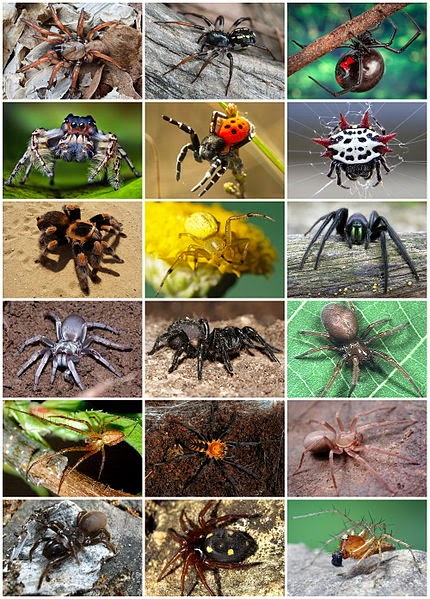Interesting Facts About Spiders
Interesting Facts About Spiders
1. Spiders have 8 eyes and 8 legs. 2. Spiders have no bones.
3. They have a hard outer shell called an ‘exoskeleton’. Because it is hard, it can’t grow with the spider. So young spiders need to molt, or shed their exoskeleton. The spider must climb out of the old shell. Can you imagine how hard it must be to pull all those legs out! As adults, they stop growing and do not need to molt.
4. Male spiders are usually smaller than females.
5. All spiders produce silk but not all spiders spin webs. Silk can be sticky, dry or stretchy.
6. As a rule of thumb: Spiders who make webs will make one new web every night.
7. Spiders are not insects because insects have 6 legs! Spiders belong to a group of animals called "arachnids".
8. To molt means to shed their outer shell.
9. Spiders have fangs. But did you know that they have pale blue blood?
10. The biggest spider is the Tarantula.
11. Spiders recycle their silk, they eat up what isn’t useful anymore.
12. Some spider’s silk is so strong that they use it for traveling. With one end attached to a surface like a tree branch, the spider will hang onto the end and let the wind carry it away (similar to Spider Man)! This is called ‘balooning’ and can take the spider many kilometers.
13. Some people have a phobia of spiders (arachnophobia). Some of these fears of spiders are because people believe they are aggressive and will attack humans with little or no provocation.
14.Spiders are not insects because they have eight legs and two body parts, called the abdomen and the thorax. In contrast, insects have three body parts and six legs.
15. Spiders have silk spinning glands, called spinnerets, at the tip of their abdomen.
16. Not all kinds of spiders can spin webs.
17. There are more than 30,000 species of spiders, all of which belong to the Arachnid family.
18. Spiders are oviparous, which means that their babies hatch from eggs.
19. Almost all spiders have six or eight eyes.
20. All spiders have fangs, which eject venom. Not all spider bites are harmful, even though they can hurt!
21. Spiders eat insects, some of which can be harmful to plants.
22. The brown recluse belongs to a group of spiders commonly known as violin spiders or fiddlebacks. The characteristic fiddle-shaped pattern is located on the top of the leg attachment region (cephalothorax). Because they are secluded and withdrawn, as their name implies, the brown recluse avoids open spaces. Brown recluse spiders are dangerous and they can bite and inject toxic venom.
23. The black widow belongs to a group of spiders commonly known as cobweb spiders. The characteristic hourglass is located on the underside of the abdomen. Female black widows are dangerous and can bite and inject toxic venom.
24. As its name suggests, the Red-back Spider has a noticeable red stripe or hourglass-shaped marking on its back, which stands out against its black body. The markings are more prominent on females.
25. In a cannibalistic mating ritual, the male Red-back Spider performs a somersault and lands on top of the female so his abdomen ends in her face. The female usually begins to eat the male while he finishes fertilising her eggs. Most males do not survive the mating process.
26. The life spent of the black widow is 1to 3 years in the wild. The size of the black widow is 1.5 in., (38mm) long, and 0.25 in (6.4mm) in diameter. The black widow weighs about 0.35 ounces(1 gram). The black widow is considered the most venomous spider in North America.
27. The Wolf spiders length is 1/5 in to 3in (1 to 8 cm). The color of the wolf spider is dark brown. The wolf spiders eat insects and other spiders. They are found all over the world. There are more than 2,000 different kinds of wolf spiders in the world. The wolf spider hunts it’s prey by running after it.


Comments
Post a Comment